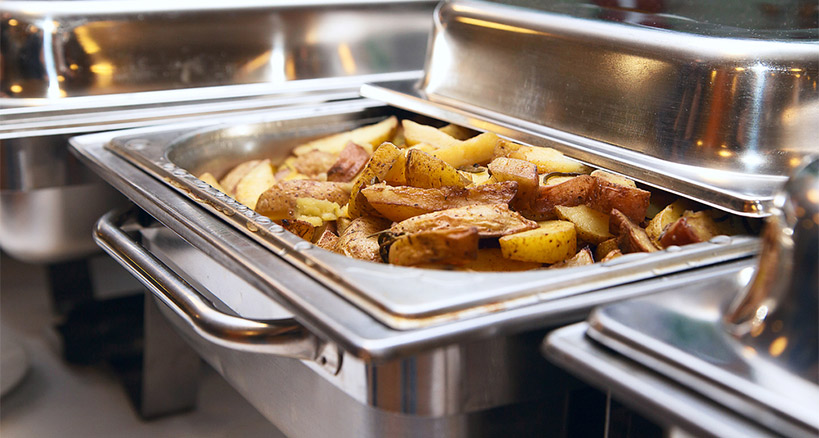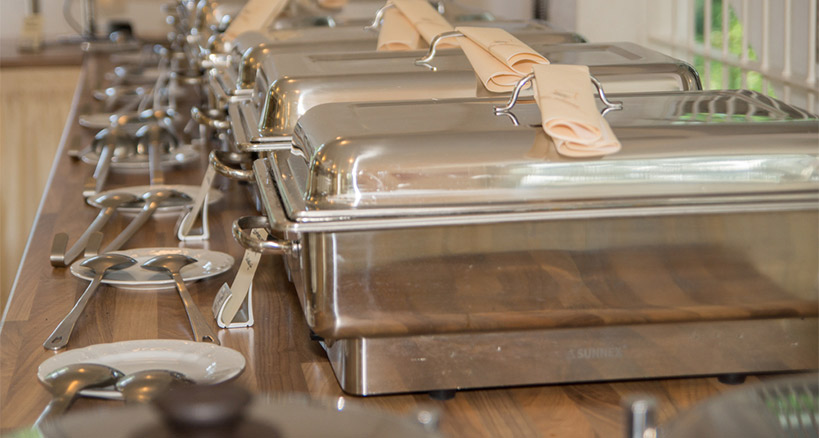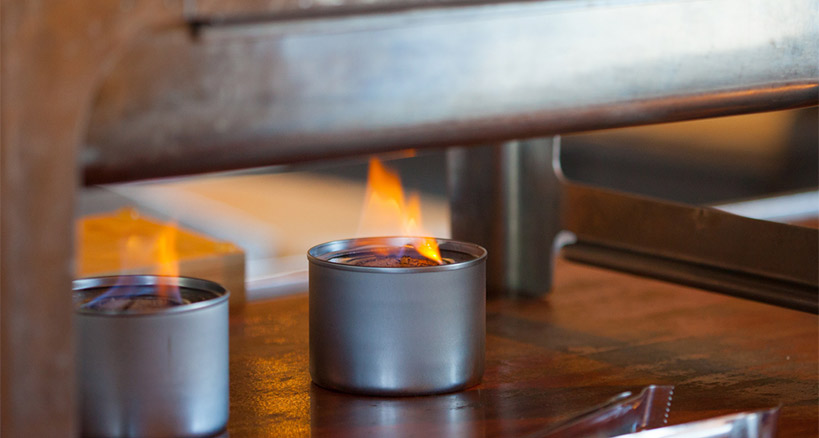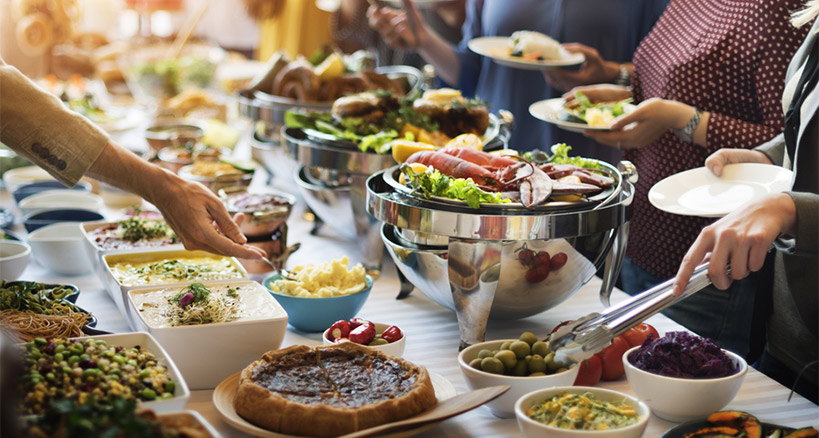
All About Chafing Dishes
A chafing dish (from the French word, chauffer, which means “to make warm”) is a portable and essential piece of equipment in the food industry. For catering businesses, the chafing dish is the foundation of any food presentation. They are also essential in restaurants that specialize in buffets with hot dishes. Chafing dishes (a.k.a. chafers) are made to keep food warm – from two to six hours – and they are the most affordable and convenient way to heat your delicious buffet items.
What is a Chafing Dish?
A chafing dish is a multi-layered apparatus: it uses chafing fuel to heat a large, shallow pan of water, which in turn heats a pan of food above it. The food in the pan stays hot, and the indirect heat, along with the water, keeps it from scorching or drying out. Electric chafers and induction chafers are other types of chafing dishes that don’t use fuel, but still use water as a medium to transfer heat, and are great for permanent buffets (like in restaurants).
Chafers aren’t used for cooking food; rather, food is prepared elsewhere and then kept warm or hot with the help of the chafing dish. Using a chafing dish is very easy. Simply heat water and add it to a water pan that is in place in a chafing dish. Light the chafer fuel or an electric source underneath the chafer dish. This will keep the food warm throughout your catered event.
Types of Chafing Dishes
There are various styles and shapes of chafers available on the market, including a range of affordable, traditional chafing dishes that use conventional gel or liquid fuel for an inexpensive and simple buffet heating solution. Induction chafers are also popular, as induction heat eliminates the need for a water pan or fuel. Induction chafers sit directly on electric induction plates and have a built-in water return system to move condensation away from food and into the water tray. Electric chafing dishes, another option, uses electricity to heat the water, and can be safer to use than traditional fuel chafers. They have no open flames or fuel sources, and they do away with the need to purchase fuel for every use. Most electric chafing dishes have variable controls, giving you the ability to precisely adjust the heat that your food is exposed to. Electric chafing dishes, and induction chafers, are also safer to use around children and in crowded, busy environments due to their enclosed stand and lack of burning fuel.
Chafing dishes need not be expensive additions to your catering equipment inventory; an eight-quart stainless-steel chafing dish can be found for less than $30. On the other hand, should you decide to splurge on something that is more aesthetically pleasing, you can opt for a chafer with a hammered copper finish, or one with a brass, gold, or chrome trim. A high-end, ornately trimmed chafing dish can cost upwards of $1,000, so if you’re looking for an excellent long-term investment and a way to impress your guests, this is the way to go.

Shapes and Sizes of Chafers
Chafers come in a variety of shapes and sizes: Main dishes are usually served in larger oval or rectangular chafing dishes, while round chafers are used for side dishes, soups and gravies.
Rectangular: The most standard style of chafing dishes, commonly used for entrees.
Round: Round chafers are more commonly used for side dishes and desserts. Some caterers use these to serve sauces and appetizers as well.
Oval: Oval chafing dishes are also used for main entrees like rectangular chafers, but give the dish a more stylish look.
Marmite/Soup: Marmite chafers are used to hold soup, as well as stews, sauces, gravies and other liquids.
Square: Square chafing dishes are somewhat less common, but are still used by caterers and restaurants for serving stylish side dishes and appetizers.
Breaking Down the Chafing Dish – From Top to Bottom
The Chafing Pan Lid
The lid of a chafing dish is used to retain heat and keep food at an even temperature. Although the lid keeps steam close to the food, retaining the food’s moistness, opening the lid is a good way to prevent certain foods from getting soggy. Different types of chafers have different types of lids, including lift-off, roll-top, hinged, and glass-top varieties. The chafer cover is an important consideration and we’ll discuss this later on.
The Food Pan
The food pan is the top part of a chafing dish – on which the lid sits – where food is placed. These come in a variety of sizes to fit your serving requirements. As chafing dishes do not cook food but only keep it warm, it is recommended that you cook food in your oven first and then transfer it to the chafing food pan.
The Water Pan
The water pan of your chafing dish is deeper than the food pan, allowing the food pan (and the food within) to be heated by the steam generated by the heated water. The pan should be filled only about one inch full.
The Chafer Stand/Frame
The chafer stand or frame is what holds and combines the individual elements of a chafer into one piece of equipment. It contains recesses or stands for the fuel and an upper rim that holds the water pan.

The Chafing Fuel
Chafing fuel comes in convenient portable cans with various burn times, and can be found in gel or liquid form.
Chafing Dish Covers – Types
To determine what type of lid you need for your chafing dish it’s important to know the crowd you’re serving. If you’re having a buffet where customers/guests will serve themselves, roll-top lids are self-serve friendly. Lift-off covers are a better option if your wait staff will be dishing out food to your guests.
Lift-Off and Dome Covers: This lid features a handle on top, making it easy to remove completely from the chafer, even while hot.
Roll-Top Covers: A roll-top cover retracts and then holds itself up. The front handle is easy to use by flipping the lid up and locking it in place.
Hinged Covers: A hinged lid acts and looks like a lift-off lid, but is hinged at an angle. This lessens the hassle of completely removing the lid, and it stays open for easier serving.
Glass Top Covers: Glass top lids allow your guests a view – albeit a steam-filled one – of the food without lifting the lid. Glass covers allow more heat to stay in the food because people won’t be lifting the lid to see what’s inside.
Chafing Dish Sizes
Chafing dishes come in three standard sizes: full-size, half-size, and round. Full-size chafing dishes have an 8- to 9-quart capacity; half-size chafers have a 4- to 5-quart capacity; and round chafers typically have a 4- to 7-quart capacity.
Chafing Fuel
Chafing fuel is extremely simple to use: Just remove the lid and light the fuel. To help control the heat, place the fuel in a holder with a dampener before igniting. Simply rotate the lid to allow more or less heat to reach the water tray. As with all spirit-based fuels, the fumes of chafing fuel are flammable, so be cautious and use a long stem lighter when igniting.
The main difference between liquid and gel chafing fuel is consistency. Gel is much thicker in consistency and is typically made using ethanol or methanol. Liquid fuel is less viscous and uses a clean-burning compound called DEG. Some wick-fed liquid fuels also have a re-sealable lid so that fuel can be reused. On the other hand, gel fuel is ignited within the can itself, and is never suitable for reuse. Gel chafing fuel typically produces a shorter flame than liquid chafing fuel and the different flame heights may suit different chafing dishes.

Setting Up a Chafing Dish
Setting up a chafing dish with fuel can be easy if you follow these simple steps:
- Place the base exactly where you want to use the chafer.
- Place the chafing fuel inside a fuel holder and remove the can lid. Attach the dampening lid (that helps adjust the heat level) to the holder and place on the stand.
- Place the empty water pan in the stand and fill with about one inch of boiling water.
- Light the fuel with a stick lighter, taking care to keep your hand away from the flame.
- Place the hot food pan on top of the water pan and close the lid.
Safe Use of Chafing Dishes
Although efficient and practical, chafing dishes that use fuel involve open flames and boiling water. It’s therefore vital to take these precautions:
- Always purchase fuel with plenty of burn time to prevent having to change canisters during the event.
- Never transfer the water pan while the water is hot. Fill with boiling water on site and allow it to cool before disposing of contents. (This goes for electric chafers, as well.)
- Always place fuels in a holder before lighting with a long lighter.
- Allow fuel canisters to completely cool before removing from holders.
- Store chafing fuel in a cool, dry place, and away from direct sunlight.
- Always supervise staff when they are assembling and lighting a chafing dish for the first time.
Cleaning Your Chafing Dishes
The water pan and food pan of a chafing dish can be pre-rinsed and cleaned in a commercial dishwasher. However, the food pan is probably stainless steel and should not be submerged in water or left wet for prolonged periods. The food pan will come in direct contact with food and should not be cleaned or polished with chemicals that are not safe for use in the kitchen. To renew the appearance of the rest of your chafer, polish the stand, fuel holder, and top of the lid with stainless steel cleaner and a microfiber cloth.
Stock Up On Chafers
If you’re serious about your catering business, investing in chafing dishes of various shapes and sizes is essential. Buffets are a significant part of your operations, and relying on hot plates or other inconsistent heating methods can be risky. Without the all-important chafer, your carefully prepared dishes might become dried out, overcooked, or entirely spoiled. Chafing dishes are the best way to ensure that your food is perfectly presented and maintained at the ideal temperature throughout your events.
Thanks for the post. The blog gives minute details of the chafing dishes. Which is very interesting and all the pics looks so good especially the one with food. Once again thanks .
never put the chaffer fuel on a wooden table like is shown in one of the pictures